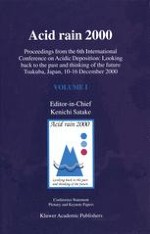2001 | OriginalPaper | Chapter
Testing the Aluminium Toxicity Hypothesis: A Field Manipulation Experiment in Mature Spruce Forest in Norway
Authors : Helene A. De Wit, Jan Mulder, Per H. Nygaard, Dan Aamlid
Published in: Acid rain 2000
Publisher: Springer Netherlands
Included in: Professional Book Archive
Activate our intelligent search to find suitable subject content or patents.
Select sections of text to find matching patents with Artificial Intelligence. powered by
Select sections of text to find additional relevant content using AI-assisted search. powered by
Aluminium (Al) has been considered to be a central element for risk evaluation of forest damage due to acidification. It has been hypothesized that Al reduces root growth, nutrient uptake and forest vitality. However, forest monitoring studies fail to show correlations between soil acidification and forest health. In general, no direct relation between Al concentration and forest health has been established. Here, Al concentrations in soil solution were manipulated by weekly additions of dilute AlCl3 to levels that are believed to be unfavorable for plant growth. Four treatments (in triplicate), including a reference and three Al addition levels, were established. Effects of enhanced Al concentrations on fine root growth, nutrient uptake and crown condition in a mature Norway spruce forest in Norway were tested (1996–1999). After three years of manipulation, crown condition, tree growth and fine root growth were not affected by potentially toxic Al concentrations. However, the Mg content in current year’s needles decreased at the highest Al addition treatment. The Mg/Al ratio of fine roots of the same treatment had declined too, which suggests that Al blocked Mg uptake at the root surface. The manipulation will be continued for two more years.
